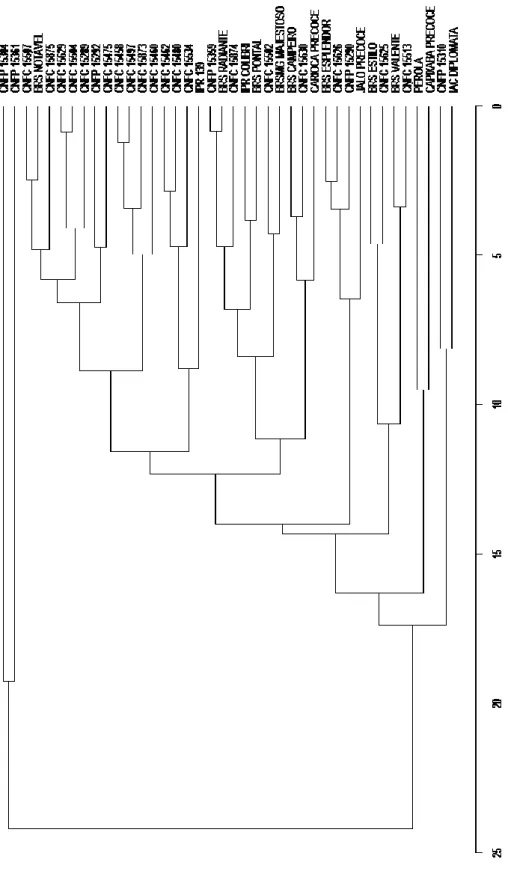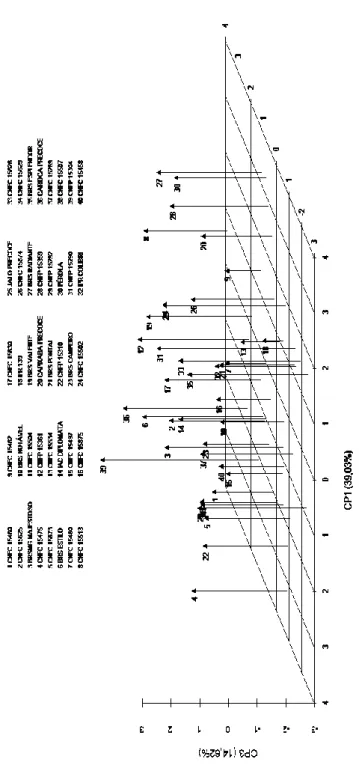Braz. J. of Develop.,Curitiba, v. 6, n.5, p.29381-29395 may. 2020. ISSN 2525-8761
Genetic variability and heritability of biofortified grain beans genotypes
Variabilidade genética e herdabilidade de genótipos de grãos biofortificados
DOI:10.34117/bjdv6n5-405
Recebimento dos originais: 20/04/2020 Aceitação para publicação: 20/05/2020
Rafael Fonsêca Zanotti
Doutor em Produção Vegetal pela Universidade Federal do Espírito Santo Instituição: Instituto Federal do Maranhão
Endereço: BR 230, KM 219, Zona Rural , São Raimundo das Mangabeiras- MA, 65840-000, Brasil
E-mail: rafael.zanotti@ifma.edu.br
José Carlos Lopes
Doutor em Ciências pela Universidade Estadual de Campinas Instituição: Universidade Federal do Espírito Santo
Endereço Alto Universitário, S/N Guararema, Alegre - ES, 29500-000, Brasil E-mail: jcufes@bol.com.br
Ludymila Brandão Motta
Doutora em Produção Vegetal pela Universidade Federal do Espírito Santo Instituição: Instituto Federal do Maranhão
Endereço: BR 230, KM 219, Zona Rural, São Raimundo das Mangabeiras- MA, 65840-000, Brasil
E-mail: ludymila.motta@ifma.edu.br
Liana Hilda Golin Mengarda
Doutora em Produção Vegetal pela Universidade Federal do Espírito Santo Instituição: Universidade Federal do Espírito Santo
Endereço Alto Universitário, S/N Guararema, Alegre - ES, 29500-000, Brasil E-mail: limengarda@gmail.com
Tiago De Souza Marçal
Doutor em Genética e melhoramento pela Universidade Federal de Viçosa Instituição: Universidade Federal de Lavras
Endereço: Campus da UFLA, Lavras-MG, CEP 37200-000, Brasil E-mail: tiago.marcal@ufla.br
Braz. J. of Develop.,Curitiba, v. 6, n.5, p.29381-29395 may. 2020. ISSN 2525-8761
José Henrique Soler Guilhen
Doutor em Genética e melhoramento pela Universidade Federal do Espírito Santo Instituição: Universidade Federal do Espírito Santo
Endereço Alto Universitário, S/N Guararema, Alegre - ES, 29500-000, Brasil E-mail: jhguilhen@gmail.com,
Carlos Eduardo Costa Paiva
Doutor em Produção Vegetal pela Universidade Federal do Espírito Santo Instituição: Universidade Federal do Espírito Santo
Endereço Alto Universitário, S/N Guararema, Alegre - ES, 29500-000, Brasil E-mail: cecostapaiva@gmail.com
ABSTRACT
Bean is the sixth most produced crop in Brazil and it is a great source of protein and minerals in human food. It is possible to select promising genotypes to form biofortified cultivars for various mineral elements, allowing to improve the nutritional quality of the grains. In this study the mineralogical diversity composition in several bean genotypes was analyzed, focusing on the selection of promising parents in the formation of biofortified cultivars. The mineralogical composition of phosphorus, calcium, magnesium, iron, manganese, potassium and zinc was analyzed. The data were analyzed using the univariate mixed model in a completely randomized design with three replicates per genotype. The results showed high genetic diversity and a possibility of genetic selection rich in calcium, iron, zinc, potassium, magnesium, manganese and phosphorus. All minerals presented high genetic variability and heritability. The richest and most genetically divergent genotypes of the “Pinto bean” commercial group were CNFC 15475 and CNFC 15625, and the black commercial group were CNFP 15310 and CNFP 15304. The selection of biofortified genotypes of elite breeding programs are extremely beneficial in selecting mineralogical rich genotypes, which already have desirable agronomic characteristics.
Key- words: breeding programs; mineral composition; Phaseolus vulgaris.
RESUMO
O feijoeiro é a sexta cultura mais produzida no Brasil e é uma grande fonte de proteínas e minerais na alimentação humana. É possível a seleção de genótipos promissores para a formação de cultivares biofortificados para vários elementos minerais, permitindo melhorar a qualidade nutricional dos grãos. Neste trabalho abordou-se a análise de diversidade da composição mineralógica em diversos genótipos de feijão com o enfoque na seleção de promissores parentais na formação de cultivares biofortificados. Realizou-se a análise da composição mineralógica de fósforo, cálcio, magnésio, ferro, manganês e zinco. Os dados foram analisados utilizando-se o modelo misto univariado em delineamento inteiramente casualisado com três repetições por genótipo. Os resultados demonstraram-se promissores, pois se encontrou alta diversidade genética e possibilidade de seleção de materiais genéticos mais ricos em cálcio, ferro, zinco, potássio, magnésio, manganês e fósforo. Todos os minerais apresentaram altas variabilidade genética e herdabilidade. Os genótipos mais ricos e divergentes geneticamente do grupo comercial carioca foram CNFC 15475 e CNFC 15625, e do grupo comercial preto foram CNFP 15310 e CNFP 15304. A seleção de genótipos biofortificados de linhagens elites dos programas
Braz. J. of Develop.,Curitiba, v. 6, n.5, p.29381-29395 may. 2020. ISSN 2525-8761 de melhoramento é extremamente benéfica por selecionar genótipos ricos mineralogicamente e que já apresentam características agronômicas desejáveis.
Palavras-chave: programas de melhoramento; composição mineral; Phaseolus vulgaris.
1 INTRODUCTION
Bean crop (Phaseolus vulgaris L.) is extremely important for the Brazilian population, and it is the sixth most produced crop in Brazil [1]. In addition to the economic importance, beans are nutritionally prominent because they represent an important source of proteins and minerals in human food [2]; [3].
A great genetic variability is observed in bean genotypes and mineralogical composition of the grains [4], showing the great potential of selecting promising genotypes richer in a certain group of minerals. These differences in mineral content are related to bean physiology, growth location, and environmental conditions [5]. There are positive and significant correlations in the mineral content [6], which facilitates the bean enrichment by more than one mineral during the selection process in breeding programs.
Superior genetic material can be researched for the purpose of developing biofortified bean lines. Currently, it is possible to increase the concentration of all minerals, however, this study focuses on the enrichment of Ca, Fe and Zn in bean seeds [7]. A very positive point is that these compounds have high heritabilities and positive correlations of their contents [7]; [6]. Therefore, the selection of genotypes and the formation of superior lineages are efficient in providing biofortified grains for these minerals [8]; [9]; [10]. The selection of nutritional richer genotypes allows to improve the nutritional quality and provide a more balanced daily diet to the population [7]; [11].
In this study the diversity of the mineralogical composition of 40 common bean genotypes was discussed, mainly focusing on how these characteristics may be useful for breeding programs. The results provide relevant information regarding genetic diversity and the possibility of selecting biofortified genotypes.
2 MATERIAL AND METHODS
Grains of 40 bean genotypes, harvested in July 2013, were provided by the Capixaba Institute for Research and Rural Extension (Incaper) (Table 1). The experiment was conducted in Sooretama-ES, following the technical recommendations for the crop.
Braz. J. of Develop.,Curitiba, v. 6, n.5, p.29381-29395 may. 2020. ISSN 2525-8761
Table 1. Ratio of genotypes used in the mineralogical composition analysis: numerical identification of the genotype (N), name of the cultivar or lineage (Genotypes), and commercial group (CG).
N Genotypes CG N Genotypes CG
1 CNFC 15460 Pinto bean 21 BRS PONTAL Pinto bean
2 CNFC 15625 Pinto bean 22 CNFP 15310 Black
3
BRSMG
MAJESTOSO Pinto bean 23 BRS CAMPEIRO Black
4 CNFC 15475 Pinto bean 24 CNFC 15502 Pinto bean
5 CNFC 15873 Pinto bean 25 JALO PRECOCE Manteigão
6 BRS ESTILO Pinto bean 26 CNFC 15874 Pinto bean
7 CNFC 15480 Pinto bean 27 BRS RADIANTE Manteigão¹
8 CNFC 15513 Pinto bean 28 CNFP 15359 Black
9 CNFC 15462 Pinto bean 29 CNFP 15292 Black
10 BRS NOTÁVEL Pinto bean 30 PÉROLA Pinto bean
11 CNFC 15504 Pinto bean 31 CNFP 15290 Black
12 CNFP 15361 Black 32 IPR COLIBRI Pinto bean
13 CNFC 15534 Pinto bean 33 CNFC 15626 Pinto bean
14
IAC
DIPLOMATA Black 34 CNFC 15629 Pinto bean
15 CNFC 15497 Pinto bean 35
BRS
ESPLENDOR Black
16 CNFC 15875 Pinto bean 36
CARIOCA
PRECOCE Pinto bean
17 CNFC 15630 Pinto bean 37 CNFC 15289 Pinto bean
18 IPR 139 Pinto bean 38 CNFC 15507 Pinto bean
19 BRS VALENTE Black 39 CNFP 15304 Black
20
CAPIXABA
PRECOCE Black 40 CNFC 15458 Pinto bean
¹Large-seeded beans
The mineralogical composition was determined according to [12], in which the extracts of the samples were obtained by nitroperchloric digestion of 500 mg of the dry mass of macerated grains for each sample. Phosphorus (P) was quantified by colorimetry; calcium (Ca), magnesium (Mg), iron (Fe), manganese (Mn) and zinc (Zn) by atomic absorption spectrophotometry and potassium (K) by flame photometry.
The data obtained from the mineralogical analysis were analyzed using the univariate mixed model in a completely randomized design with three replicates per genotype [13]. The Restricted Maximum Likelihood (REML) method [14] was used to estimate genetic parameters using the Expectation–Maximization algorithms [15].
Braz. J. of Develop.,Curitiba, v. 6, n.5, p.29381-29395 may. 2020. ISSN 2525-8761 Estimates of the genetic parameters for the mixed model were calculated following the procedure: ĥg2 = σ̂g 2 σ̂f2 r̂ĝg = ( 1 1 + σ̂e2 rσ̂g2 ) 1 2 CVe(%) = √σ̂e2 μ̂ 100 ĥmc 2 = ( 1 1 + σ̂e2 rσ̂g2 ) CVg(%) = √σ̂g2 μ̂ 100 CVr = √σ̂g2 √σ̂e2 ,
In which: σ̂e2 is the residual variance estimation; σ̂g2 is the estimate of the genotypic variance; σ̂f2 is the estimate of the phenotypic variance; ĥg2 is the individual heritability in a
broad sense; r is the number of repetitions used; ĥg̅2 is the heritability of the mean of genotypes; r̂g̃g is the accuracy of genotype selection; μ̂ is the overall mean estimate; CVg(%) is the coefficient of variation genotypic; CVe(%) is the coefficient of experimental variation and CVr
is the coefficient of relative variation.
The genetic means were ranked and selected by the ranks sum index methodology of [16], where the genotypic values were classified for each characteristic and the rank sum of each genotype for all the characteristics was presented as a final result.
The genetic distance used to demonstrate the genetic divergence among the genotypes was Mahalanobis, and a principal component analysis was also performed to demonstrate the dispersion of the genetic means. All statistical analyzes and graphs were done using software R [17].
3 RESULTS AND DISCUSSION
We can be observed that the concentration range of the minerals in the genotypes was: P (44.4 to 61.9 mg 100 g -1), Mg (144.4 to 205.5 mg 100 g -1), Ca (0.8 to 3.2 g kg -1), K (15.6 to
21.1 g kg -1), Mn (1.0 to 2.8 mg 100 g -1), Fe (5.82 a 13.6 mg 100 g-1) and Zn (2.8 to 4.6 mg 100
g-1) of 40 bean genotypes.
The values of potassium and phosphorus found in this study were higher than those found by [18], while magnesium concentrations were lower. Regarding manganese, the mean concentration found was lower than [19], however, some genotypes of this study presented similar values to the genotypes with the highest concentrations.
Braz. J. of Develop.,Curitiba, v. 6, n.5, p.29381-29395 may. 2020. ISSN 2525-8761 The mean values of zinc were similar to those found by [18] and [10], however, these values were higher than the average found by [20]. The possibility of increasing the concentration of zinc in bean genotypes is high, since there is a great genetic variation that can be explored, and the Cvr was above 1.0 in this study (Table 2), as well as for [20]. The Cvr ratio
above one unit shows that the genotype variation is greater than the environmental variation, making it possible to select genotypes with higher concentrations of zinc in the grains.
The average iron contents found in this study (Table 2) presented values similar to those found in other studies [19], [18]; [21]. However, it is observed that the genetic diversity of iron concentration allows to greatly increase the concentration of this mineral in the grains. [21] observed that the average obtained was higher than the highest level found in this study, and that the SSD (single seed descendent) method allowed gains higher than the values obtained here [22].
All the minerals studied presented average heritability above 80% (Table 2), which suggests a great possibility of success in the selection of superior genotypes for the mineral content and reflects in higher gains by selection [23]. In general, characteristics with high heritability are controlled by a smaller number of genes than characteristics that have low heritability [24], facilitating the transmission of traits for the progeny.
The calcium contents were higher than those found by [18], [10] and [21], and similar to those found by [19]. Calcium is a mineral that has the highest concentration in the grain integument [25] and has a maternal effect [8]. Therefore, the selection of common bean genotypes in this material is difficult because the crossing greatly influences the composition of calcium in the grains.
The coefficients of variation of the experiment were low for most minerals, with only calcium having a higher coefficient of residual variation (22.24%), suggesting a significant contribution of environmental effect, and not only genetic variation (Table 2). However, the ratios were higher than 1, which indicates that the genetic variation was greater than the environmental variation, although the mineralogical composition in bean grains was influenced by the interaction genotype x environment. The higher the value of the CVr ratio (above 1), the
better it is for breeding programs, due to indicating a high variability and great possibility of selection of promising materials for this characteristic.
Braz. J. of Develop.,Curitiba, v. 6, n.5, p.29381-29395 may. 2020. ISSN 2525-8761
Table 2. Estimation of genetic and non-genetic parameters of 40 common bean genotypes (P. vulgaris), in relation to the compositions; calcium (Ca), potassium (K), phosphorus (P), magnesium (Mg), manganese (Mn) ,
iron (Fe) and zinc (Zn).
Variables Ca K P Mg Mn Fe Zn (g Kg-1) (mg 100g-1) 0.586 2.074 23.633 325.271 0.139 5.186 0.168 0.192 0.404 5.532 208.595 0.005 1.019 0.022 0.778 2.478 29.165 533.866 0.144 6.205 0.189 0.902 0.939 0.928 0.824 0.989 0.939 0.959 CVg (%) 38.863 7.786 8.935 10.454 20.789 25.166 11.574 CVe (%) 22.243 3.435 4.323 8.372 3.885 11.158 4.136 CVr 1.747 2.267 2.067 1.249 5.352 2.255 2.798 Accuracy 0.95 0.969 0.963 0.908 0.994 0.969 0.979 Xo 1.97 18.498 54.408 172.516 1.794 9.049 3.541 Xs 2.967 20.445 60.826 198.935 2.377 12.702 4.137 GS (%) 45.656 9.889 10.944 12.617 32.107 37.894 16.13 LRT 74.6 ** 105.1 ** 93.8 ** 42.9 ** 227.2 ** 104.5 ** 132.7 ** σ
̂g2: estimation of the genotype variance component, σ̂e2: estimation of the component of experimental variance, σ̂f2: estimation of the component of phenotypic variance, ĥg̅2: estimate of average heritability, CVg (%): estimation of the coefficient of variation genetic, CVe (%): estimation of the experimental coefficient of variation, CVr:
estimation of the relative coefficient of variation,
r̂g̃g: estimation of selective accuracy, Xo: original average, Xs: – average of selected (8), GS (%) – selection gain,
and LRT: likelihood ratio test.
All minerals showed high selection gains for selection intensity of 20%, and in descending order the elements were: calcium> iron> manganese> zinc> magnesium> phosphorus> potassium. Calcium was the mineral that most stood out, with a possible gain of more than 45% (Table 2).
The results found for heritability, genetic variation, CVr ratio, selection gain, and high
accuracy of this experiment (> 0.90), reinforce the possibility of using efficient selection of biofortified genetic materials (Table 2).
The mineral elements, among them, presented positive genetic correlations, for the most part, except for phosphorus with manganese; and iron with magnesium, calcium and manganese (Figure 1). Positive correlations between the elements favor the selection of genotypes rich in more than one mineral during the breeding process [6].
Braz. J. of Develop.,Curitiba, v. 6, n.5, p.29381-29395 may. 2020. ISSN 2525-8761 The genotypes that presented the highest concentrations of each mineral were: CNFC 15460, CNFC 15475 and CNFC 15873 (P); CNFC 15475 ,CNFP 15310 and Carioca Precoce (Mg); CNFC 15460 and CNFC 15513 (Ca); CNFC 15504, CNFP 15310 and CNFC 15629 (K); CNFC 15513, Carioca Precoce and CNFP 15304 (Mn); CNFC 15475 , CNFP 15292 e CNFP 15290 (Fe); CNFC 15873 e CNFP 15304 (Zn) (Table 3). All these genotypes are promising for the formation of biofortified progenies by crossbreeding directed to each mineral.
Figure 1. Heatmap obtained from the genetic correlation matrix between the concentrations of phosphorus, magnesium, calcium, potassium, manganese, iron and zinc.
The process of genetic improvement is methodical, and the researcher can use different strategies. In this work, the genotype selected for the eight minerals is different than when selecting only for calcium, zinc and iron. Therefore, when the objective is to select materials rich in all minerals, the most promising genotypes are CNFC 15460 (1), CNFC 15625 (2), CNFC 15475 (4), CNFC 15504 (11), CNFP 15310 (22), CNFC 15629 (34), CNFC 15507 (38) and CNFP 15304 (39) (Table 3).
When selecting genotypes focusing only on the minerals Fe, Ca and Zn, the most indicated parents are CNFC 15475 (4) and CNFP 15304 (39). It should be noted that the CNFC 15475 genotype was the first selected by the ranks sum index, mainly because this genotype showed
Braz. J. of Develop.,Curitiba, v. 6, n.5, p.29381-29395 may. 2020. ISSN 2525-8761 the highest concentrations of minerals, with the exception of calcium and manganese. During the breeding process, there is a high probability of generating new biofortified lineages from the crossbreeding of these indicated parents.
Table 3. Genotypic values of phosphorus (P), magnesium (Mg), calcium (Ca), potassium (K), manganese (Mn), iron (Fe), zinc (Zn) and the ranks sum of [16] of 40 bean (Phaseolus vulgaris L.)
Genotype P Mg Ca K Mn Fe Zn Ranks¹ sum CNFC 15460 61.9 180.4 3.1 19.3 1.9 8.5 3.8 82 CNFC 15625 56.7 184.3 2.8 17.4 2 9.1 3.9 93 BRSMG MAJESTOSO 53.8 175.4 1.5 19.3 1.8 10.2 4.1 121 CNFC 15475 61.6 198.1 2.5 20.4 1.8 12.9 4 48 CNFC 15873 61.7 173.3 2.2 19.1 1.6 9.7 4.2 103 BRS ESTILO 57.2 192.7 2.7 16.5 2.2 11.2 3.7 97 CNFC 15480 54.2 176.2 2.7 18.9 1.6 6.2 3.3 161 CNFC 15513 45.9 188.8 3.2 17.2 2.5 5.8 3.1 158 CNFC 15462 50.3 166 2.8 18.2 1.6 6.2 2.8 195 BRS NOTÁVEL 55.1 167 2.3 19.9 1.6 9.9 3.3 143 CNFC 15504 59.5 185.2 2.1 20.5 1.9 11 3.5 85 CNFP 15361 47.2 181 2.8 17.8 2.2 7.3 4.1 124 CNFC 15534 52.4 169.2 2.4 18.4 1.2 7.9 3.1 189 IAC DIPLOMATA 54.1 195 2.1 18.5 1.8 7.2 4 129 CNFC 15497 58.5 176.4 2.3 20.3 1.5 8.2 3.7 117 CNFC 15875 54.9 188.8 2.4 19.4 1.7 8.7 3.1 131 CNFC 15630 53.2 186 1.6 19.8 2.3 7 3.5 131 IPR 139 57.3 152.1 2.8 17.2 1 6.6 3.3 188 BRS VALENTE 50 184.6 2.4 17.5 2.3 8.7 3.3 137 CAPIXABA PRECOCE 53.9 156 1.7 15.8 1.7 7.6 2.8 212 BRS PONTAL 54.2 149.4 0.9 19.5 1.4 8.1 3.4 191 CNFP 15310 60.2 196.8 1.2 21.1 1.6 8.6 4.1 88 BRS CAMPEIRO 58 188.6 2.3 19.6 1.9 7.5 3.6 110 CNFC 15502 47.1 165.4 1.2 18.8 1.9 8.9 3.4 168 JALO PRECOCE 48.8 163.1 1.3 16.7 1.6 12.4 3.2 192 CNFC 15874 52.2 159.3 1.7 17.3 1.7 7.7 3.3 195 BRS RADIANTE 44.4 149.9 1 17 2 6.4 3.1 227 CNFP 15359 46.7 151 0.9 17.6 2 6.8 3 221 CNFP 15292 58.9 168.6 1.2 19.7 1.5 13.1 3.8 120 PÉROLA 47.2 159.8 0.9 15.6 1.7 6 3.1 241 CNFP 15290 51.9 152.1 1.1 16.9 1.8 13.6 3.4 177
Braz. J. of Develop.,Curitiba, v. 6, n.5, p.29381-29395 may. 2020. ISSN 2525-8761 IPR COLIBRI 55.2 149.6 1 18.2 1.3 8 3.7 191 CNFC 15626 52.5 145.9 1 17.4 1.5 12 3.6 190 CNFC 15629 59.8 182 2.4 20.5 1.9 11.8 3.4 78 BRS ESPLENDOR 55.8 144.4 0.8 16.8 1.4 12.5 3.6 192 CARIOCA PRECOCE 54.1 205.5 1.8 19 2.7 7.6 3.8 107 CNFC 15289 59.1 164.2 2 18.7 1.7 11.6 3.5 130 CNFC 15507 57.7 188 2.7 20.2 1.8 10.6 3.7 76 CNFP 15304 54.5 170.9 2.8 18.5 2.8 10.2 4.6 81 CNFC 15458 58.4 169.6 2.4 19.5 1.5 8.5 3.9 121
¹ Underlined values represent the genotypes selected by the Ranks Sum [16].
The most dissimilar genotypes, among the 40, were CNFP 15304 (39) and CNFP 15361 (12), as can be observed in the UPGMA cluster (Figure 2). The use of these two genotypes as parents for the formation of segregating populations in breeding programs is quite interesting. In addition, the CNFP 15304 genotype was also one of the eight genotypes selected by ranks sum index, and stood out in the graphic dispersion of the main components (Figure 3). These materials belong to two distinct commercial groups (Pinto bean and Black, respectively), and they can be used as promising parents in crossbreeding, viewing to increase mineralogical concentrations, since they are not registered as cultivars.
It is observed by the graph of main components that among the eight materials selected by the ranks sum index (Table 3), the most divergent of the Pinto bean group are CNFC 15475 (4) and CNFC 15625 (2) and the Black group are CNFP 15310 (22) and CNFP 15304 (39). These materials within each group are promising parents for the development of biofortified cultivars for most of the minerals studied. Targeted crossbreeding of genotypes for the development of cultivars are extensively investigated in bean breeding [8]; [9]; [25]; [26]; [4], and increases the concentration of minerals in the grains [7]; [26]. For the development of new biofortified cultivars, the existence of genotype x environment interaction must be considered, and the occurrence of maternal effect [18].
Braz. J. of Develop.,Curitiba, v. 6, n.5, p.29381-29395 may. 2020. ISSN 2525-8761
Figure 2. Dendrogram obtained by the hierarchical grouping of the mean linkage between groups (UPGMA), from the generalized distance of Mahalanobis among 40 bean genotypes, grouped from the variables
Braz. J. of Develop.,Curitiba, v. 6, n.5, p.29381-29395 may. 2020. ISSN 2525-8761
Figure 3. Graphical dispersion of the 40 bean (P.vulgaris) genotypes in relation to the first three main components (CP1, CP2 and CP3) based on the Mahalanobis distances for the genetic averages of the variable
concentrations of phosphorus, magnesium, calcium, potassium , manganese, iron and zinc.
It is highlighted in this study that the eight genotypes that present the highest concentrations of all mineralogical elements are non-commercial lineages, which enables the breeder to use these lineages to launch new biofortified cultivars.
Braz. J. of Develop.,Curitiba, v. 6, n.5, p.29381-29395 may. 2020. ISSN 2525-8761
4 CONCLUSION
There is a great genetic diversity to be explored in the bean crop and used by crop breeders. Achieving high selection gains is possible for all the minerals studied, with emphasis on calcium and iron. CNFC 15475 and CNFC 15625 genotypes are the genetic materials indicated as promising parents in the increment of minerals in beans of the Pinto bean commercial group, while CNFP 15310 and CNFP 15304 genoytpes are the most promising parents for the Black commercial group.
ACKNOWLEDGMENT
Thanks to the Coordination of Improvement of Higher Education Personnel (CAPES / REUNI), National Council for Scientific and Technological Development (CNPq) for the granting the scholarships and productivity, respectively, and INCAPER, Capixaba Institute for Research, Technical Assistance and Extension Rural, for supplying the seeds.
REFERENCES
Anonymous, Acompanhamento da safra brasileira de grãos: 9º Levantamento (2015), Vol 2, (CONAB - Companhia Nacional de Abastecimento, Brasília, BR), 2015, 1-104. https://www.conab.gov.br/infoagro/safras/graos/boletimdasafradegraos/item/download/1290_0 c593ee0b2d2259f8e84778987f08a51
Plans M, Simó J, Casañas F, Sabaté J & Rodriguez-Saona L, Characterization of common beans (Phaseolus vulgaris L.) by infrared spectroscopy: comparison of MIR, FT-NIR and dispersive NIR using portable and benchtop instruments. Food Research International, 54 ( 2) (2013) 1643–1651. https://www.sciencedirect.com/science/article/abs/pii/S0963996913004900
Pedrosa M M, Cuadrado C, Burbano C, Muzquiz M, Cabellos B, Olmedilla-Alonso B & Asensio-Vegas C, Effects of industrial canning on the proximate composition, bioactive compounds contents and nutritional profile of two Spanish common dry beans (Phaseolus vulgarisL.),FoodChemistry,166(2015)6875.https://www.sciencedirect.com/science/article/abs/ pii/S0308814614008887?via%3Dihub
Ceyhan E, Harmankaya M & Kahraman A, Combining ability and heterosis for concentration of mineral elements and protein in common bean (Phaseolus vulgaris L.), Turkish Journal of AgricultureandForestry,38(2014)110.https://journals.tubitak.gov.tr/agriculture/abstract.htm?id =15129
Ferreira As, Naozuka J, Kelmer G A & Oliveira P V, Effects of the domestic cooking on elemental chemical composition of beans species (Phaseolus vulgaris L.), Journal of Food Processing, (2014) 1–6. http://downloads.hindawi.com/archive/2014/972508.pdf
Braz. J. of Develop.,Curitiba, v. 6, n.5, p.29381-29395 may. 2020. ISSN 2525-8761 Kahraman A & Önder M, Correlations between seed color and nutritional composition of dry bean, Ratarstvo i povrtarstvo, 50(2) (2013) 8–13. http://see-articles.ceon.rs/data/pdf/1821-3944/2013/1821-39441302008K.pdf
Ribeiro N D, Potencial de aumento da qualidade nutricional do feijão por melhoramento genético, Semina: Ciências Agrárias, 31 (4) (2010) 1367-1376. http://www.uel.br/revistas/uel/index.php/semagrarias/article/view/2485/6944
Jost E, Ribeiro N D, Maziero S M, Cerutti T & Rosa D P, Efeitos gênicos do teor de cálcio em grãos de feijão, Ciência Rural, 39(1), (2009) 31–37. http://www.scielo.br/pdf/cr/v39n1/a55cr689.pdf
Rosa S S, Ribeiro N D, Jost E, Reiniger L R S, Rosa D P et al., Potential for increasing the zinc content in common bean using genetic improvement, Euphytica, 175( 2) (2010) 207–213. https://link.springer.com/article/10.1007%2Fs10681-010-0163-6
Silva C A, Abreu A D F B, Ramalho M A P & Maia L G S, Chemical composition as related to seed color of common bean, Crop Breeding and Applied Biotechnology, 12 (2012) 132–137. https://www.alice.cnptia.embrapa.br/alice/bitstream/doc/929215/1/cbab.pdf
Gouveia C S S, Freitas G, Brito J H, Slaski J J & Carvalho M A P, Nutritional and mineral variability in 52 accessions of common bean varieties (Phaseolus vulgaris L.) from Madeira
Island, Agricultural Sciences, 5 (2014) 317–329.
https://www.scirp.org/pdf/as_2014032110022170.pdf
Malavolta E, Vitti G C & Oliveira A S, Avaliação do estado nutricional das plantas: princípios e aplicações, (Potafos, Piracicaba, BR), 1997.
Resende M D V, Genética Biométrica e Estatística no Melhoramento de Plantas Perenes, (Embrapa Informação Tecnológica, Brasília, BR), 2002, 975.
PATTERSON HD & THOMPSON R Recovery of inter-block information when block sizes are unequal, Biometrika. 58 (3) (1971) 545-54. https://academic.oup.com/biomet/article-abstract/58/3/545/233494
Dempster A P, Laird N M & Rubin D B, Maximum likelihood from incomplete data via the EM algorithm, Journal of the Royal Statistical Society, 39 (1) (1977) 1-38. https://www.stat.purdue.edu/~chuanhai/teaching/QualPrep/Docs/DLR.pdf
Mulamba N N & Mock J J, Improvement of yield potential of the Eto Blanco maize (Zea mays L.) population by breeding for plant traits, Egyptian Journal of Genetics and Cytology, 7 (1) (1978) 40-51.
Anonymous, A language and environment for statistical computing, (R CORE TEAM. R Foundation for Statistical Computing. Vienna, AUT) , 2014.
PEREIRA T, COELHO C M M, SANTOS J C P D, BOGO A & MIQUELLUTI D J, Diversidade no teor de nutrientes em grãos de feijão crioulo no Estado de Santa Catarina, Acta
Braz. J. of Develop.,Curitiba, v. 6, n.5, p.29381-29395 may. 2020. ISSN 2525-8761 ScientiarumAgronomy,33(3)(2011)477485.http://periodicos.uem.br/ojs/index.php/ActaSciAgr on/article/view/6328/6328
Mesquita F R, Corrêa A D, Abreu C M P, Lima R A Z & Abreu A F B, Linhagens de feijão (Phaseolus vulgaris L.): composição química e digestibilidade proteica, Ciência e Agrotecnologia,31(1)(2007)11141121.https://www.alice.cnptia.embrapa.br/alice/bitstream/doc /215853/1/26.pdf
Ribeiro N D, Jost E, Cerutti T, Maziero S M & Poersch N L, Composição de microminerais em cultivares de feijão e aplicações para o melhoramento genético, Bragantia, 67( 2) (2008) 267-273. http://www.scielo.br/pdf/brag/v67n2/a02v67n2.pdf
Ribeiro N D, Jost E, Maziero S M, Storck L & Rosa D P, Selection of common bean lines with high grain yield and high grain calcium and iron concentrations, Revista Ceres, 61(1) (2014) 77-83. http://www.scielo.br/pdf/rceres/v61n1/v61n1a10.pdf
Ribeiro N D, Rodrigues J D A, Prigol M, Nogueira C W, Storck L, et al., Evaluation of special grains bean lines for grain yield, cooking time and mineral concentrations, Crop Breeding and
Applied Biotechnology, 14 (1) (2014) 15-22.
http://www.sbmp.org.br/cbab/siscbab/uploads/c8eb9792-6c89-3fb0.pdf
Cruz C D, Regazzi A J & Carneiro P C S, Modelos biométricos aplicados ao melhoramento genético, 3.ed, (Ed. UFV , Viçosa, BR), 2004,1
Flint‑Garcia S A, Thuillet A C, Yu J M, Pressoir G, Romero S M, et al., Maize association population: a high‑resolution platform for quantitative trait locus dissection, The Plant Journal, 44(2005)1054‑1064.https://onlinelibrary.wiley.com/doi/epdf/10.1111/j.1365313X.2005.02591. x
Ribeiro N D, Maziero S M, Prigol M, Nogueira C W, Rosa D P, et al., Mineral concentrations in the embryo and seed coat of common bean cultivars, Journal of Food Composition and Analysis,26(12)(2012)8995. https://www.sciencedirect.com/science/article/pii/S08891575120 00440
Poersch N L, Ribeiro N D, Rosa, D P, Maziero S M & Jost E, Genetics of the concentration of copper in common bean seeds, Acta Scientiarum. Agronomy, 35(3) (2013) 301-306. http://www.scielo.br/pdf/asagr/v35n3/v35n3a05.pdf
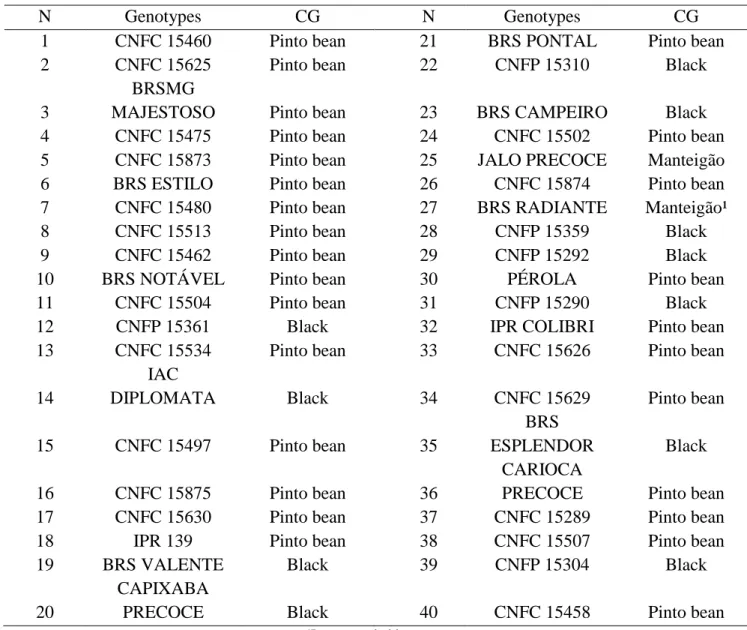
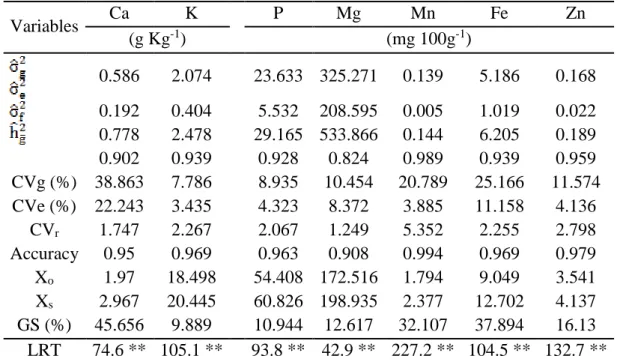
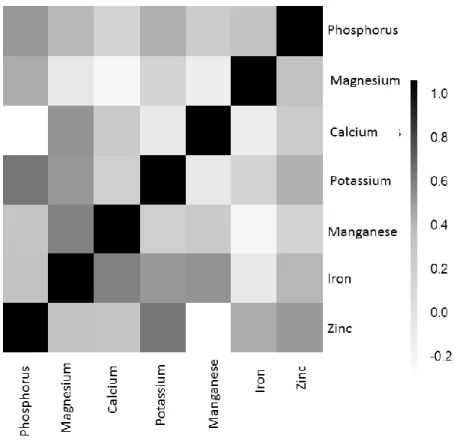
![Table 3. Genotypic values of phosphorus (P), magnesium (Mg), calcium (Ca), potassium (K), manganese (Mn), iron (Fe), zinc (Zn) and the ranks sum of [16] of 40 bean (Phaseolus vulgaris L.)](https://thumb-eu.123doks.com/thumbv2/123dok_br/17917017.850100/9.892.194.764.284.1126/genotypic-phosphorus-magnesium-calcium-potassium-manganese-phaseolus-vulgaris.webp)
